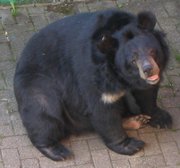
Wildlife of Afghanistan
Encyclopedia

Afghanistan
Afghanistan , officially the Islamic Republic of Afghanistan, is a landlocked country located in the centre of Asia, forming South Asia, Central Asia and the Middle East. With a population of about 29 million, it has an area of , making it the 42nd most populous and 41st largest nation in the world...
has long been known for its rich and diverse wildlife, as recorded in the memoirs of Babur
Babur
Babur was a Muslim conqueror from Central Asia who, following a series of setbacks, finally succeeded in laying the basis for the Mughal dynasty of South Asia. He was a direct descendant of Timur through his father, and a descendant also of Genghis Khan through his mother...
, founder of the Mughal dynasty that ruled the country from 1483 to 1530. Tigers and cheetahs have been present in lowland parts of Afghanistan until the mid-twentieth century.
For the majority of people in Afghanistan
Afghanistan
Afghanistan , officially the Islamic Republic of Afghanistan, is a landlocked country located in the centre of Asia, forming South Asia, Central Asia and the Middle East. With a population of about 29 million, it has an area of , making it the 42nd most populous and 41st largest nation in the world...
, natural resources are the source of their livelihood and the basis of their existence. “Virtually the entire land surface of Afghanistan has been used for centuries – whether for local farming or, on a more wide-reaching basis, for livestockgrazing, fuelwood collection and hunting”, says Pekka Haavisto, Chairman of the Afghanistan Task Force of the United Nations Environment Programme
United Nations Environment Programme
The United Nations Environment Programme coordinates United Nations environmental activities, assisting developing countries in implementing environmentally sound policies and practices. It was founded as a result of the United Nations Conference on the Human Environment in June 1972 and has its...
(UNEP) and former Finnish Minister for Environment. In 2003 a Post-Conflict Environment Assessment Report, revealed how warfare in Afghanistan had degraded the environment. The report partly also focused on the dramatic decrease of wildlife due to poaching, and outlines ways to respond to these threats.
Many of the larger mammals
Mammal
Mammals are members of a class of air-breathing vertebrate animals characterised by the possession of endothermy, hair, three middle ear bones, and mammary glands functional in mothers with young...
in the country are categorized by IUCN as globally threatened. These include the Snow Leopard
Snow Leopard
The snow leopard is a moderately large cat native to the mountain ranges of South Asia and Central Asia...
, the Markhor
Markhor
The Markhor is a large species of wild goat that is found in northeastern Afghanistan, Pakistan , India, southern Tajikistan and southern Uzbekistan...
, the Marco Polo Sheep
Marco Polo sheep
The Marco Polo sheep is a subspecies of argali sheep, named after Marco Polo. Their habitat is the mountainous regions of Central Asia. Marco Polo sheep are distinguishable mostly by their large size and spiraling horns. Their conservation status is "near threatened" and efforts have been made to...
, the Urial
Urial
The Urial , also known as the Arkars or Shapo, is a subspecies group of the wild sheep Ovis orientalis. Noticeable features are the reddish-brown long fur that fades during winter; males are characterized by a black ruff stretching from the neck to the chest and large horns. It is found in western...
, and the Asiatic Black Bear
Asiatic Black Bear
The Asian black bear , also known as the moon bear or white-chested bear is a medium-sized species of bear, largely adapted for arboreal life, which occurs through much of southern Asia, Korea, northeastern China, the Russian far east and Honshū and Shikoku islands of Japan...
. Other species of interest are the Ibex, the Gray Wolf, and the Brown Bear. Most of the Marco Polo sheep and Ibex are being poached for food, whereas wolves, Snow leopards and bears are being killed for damage prevention.
The fur, however, is being sold to aid workers and foreign soldiers as souvenirs on local markets.
With two million returning refugees in 2002 and a further 1.5 million expected in 2003, the pressure on Afghanistan’s natural resource
Natural resource
Natural resources occur naturally within environments that exist relatively undisturbed by mankind, in a natural form. A natural resource is often characterized by amounts of biodiversity and geodiversity existent in various ecosystems....
s are set to increase further. The UNEP Report makes it clear that environmental
Natural environment
The natural environment encompasses all living and non-living things occurring naturally on Earth or some region thereof. It is an environment that encompasses the interaction of all living species....
restoration must play a major part in the reconstruction efforts in Afghanistan.
Sampling Afghanistan's wildlife
- Altai weasel (Mustela altaica)
- Asiatic black bear (Ursus thibetanus)
- Asiatic brown bear (Ursus arctos)
- Caracal (Caracal caracal)
- Eurasian Otter (Lutra lutra)
- Geoffroy's Bat (Myotis emarginatus)
- Gray wolf (Canis lupus)
- Hare (Lepus tolai)
- Ibex (Capra ibex sibirica)
- Kashmir Cave Bat (Myotis longipes)
- Leopard (Panthera pardus)
- Lesser Horshoe Bat (Rhinolophus hipposideros)
- Long-tailed marmot (Marmota caudata)
- Lynx (Lynx lynx)
- Marco Polo sheep (Ovis ammon polii)
- Markhor (Capra falconeri)
- Mehely's Horseshoe Bat (Rhinolophus mehelyi)
- Mouflon (or Urial) (Ovis orientalis)
- Pallas’ cat (Otocolobus manul)
- Pikas (Ochotona sp)
- Red fox (Vulpes vulpes)
- Sind Bat (Eptesicus nasutus)
- Snow Leopard (Uncia uncia)
- Stoat (Mustela erminea)
- Stone marten (Martes foina)
- Wild Goat (Capra aegagrus)
- Zarudny's Jird (Meriones zarudnyi)

